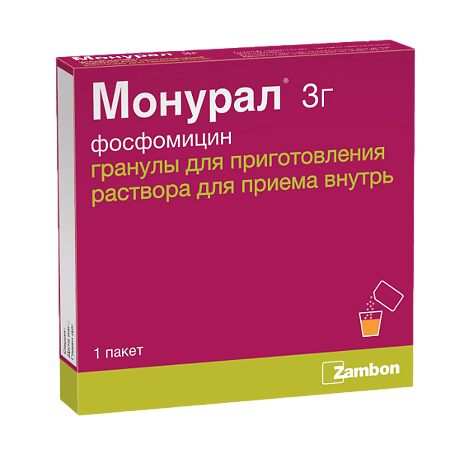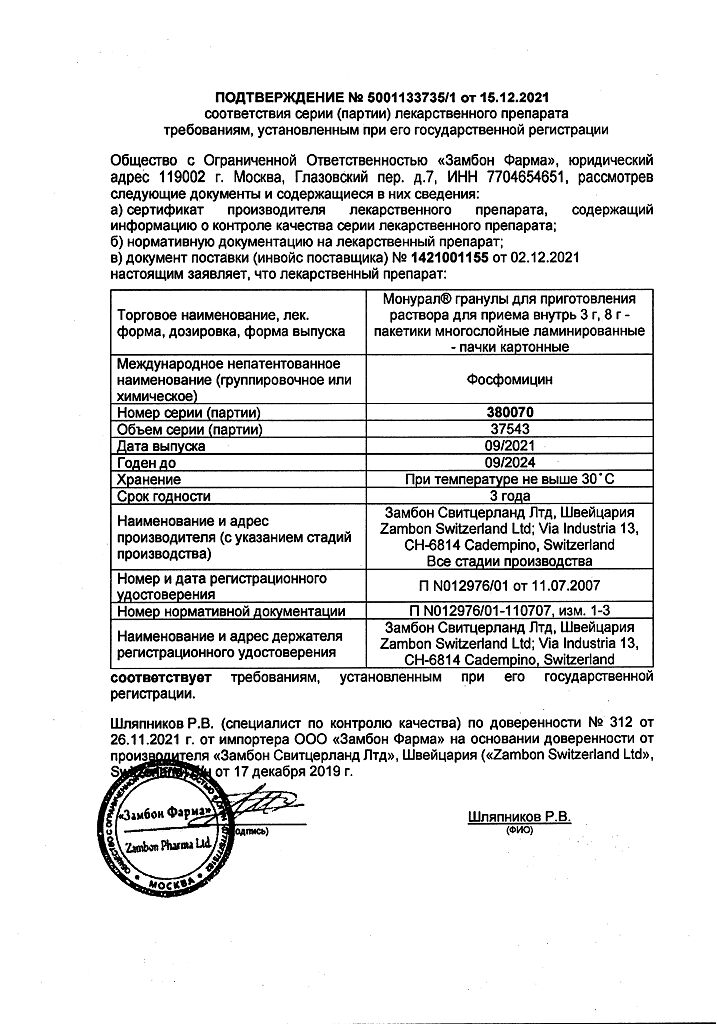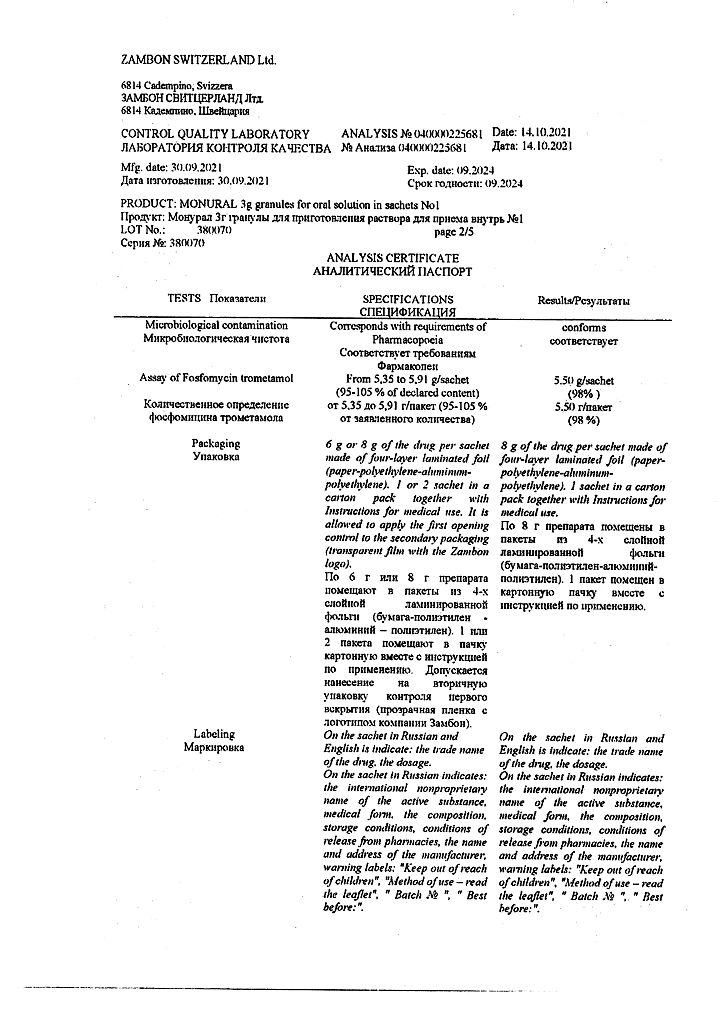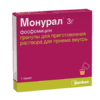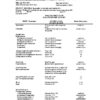No products in the cart.
Description
Pharmacotherapeutic group
antibiotic
ATX code^J01XX01.
Pharmacological properties
Pharmacodynamics.
Monural® contains phosphomycin [mono (2-ammonium-2-hydroxymethyl-1,3-propanediol)(2R-cis)-(3-methyloxyranil) phosphonate] – a broad spectrum antibacterial agent, a phosphonic acid derivative intended to treat urinary tract infections. The mechanism of action is associated with inhibition of the first stage of synthesis of the bacterial cell wall. Being a structural analogue of phosphoenolpyruvate it competitively inhibits irreversibly the enzyme UDF-N-acetylglucosamienolpyruviltransferase, which catalyzes the reaction of formation of UDF-N-acetyl-3-O-(1-carboxyvinyl)-B-glucosamine from phosphoenolpyruvate and UDF-N-acetyl-D-glucosamine.
The drug is also able to reduce bacterial adhesion to the bladder mucosa, which can play the role of a predisposing factor for recurrent infections. The mechanism of action of the drug explains the absence of cross-resistance with other antibiotics and the mutual enhancement of action with antibiotics of other classes, such as beta-lactam antibiotics.
Phosphomycin is active against a wide range of Gram-positive and Gram-negative microorganisms commonly isolated in urinary tract infections, such as Escherichia coli, Citrobacter spp., Klebsiella spp., Proteus spp., Serratia spp., Pseudomonas aeruginosa, Enterrococcus faecalis. The emergence of resistance under laboratory conditions is explained by mutations in the gIpT and uhp genes, which control L-alpha-glycerophosphate and glucose phosphate transport, respectively.
Pharmacokinetics.
Intake: When administered orally, phosphomycin is well absorbed from the intestine and achieves a bioavailability of about 50%. Maximum concentration in plasma is observed 2-2.5 hours after oral administration and is 22-32 mg/l. The plasma elimination half-life is 4 hours.
Ingestion with food slows absorption without affecting the concentration in the urine.
Distribution: Fosfomycin is distributed in the kidneys, bladder wall, prostate and seminal glands. A steady urinary concentration of fosfomycin exceeding the Minimum Bacteriostatic Concentration (MBc) is reached 24-48 hours after oral administration.
Phosphomycin does not bind to plasma proteins and crosses the placental barrier.
Fosfomycin is excreted into breast milk in small amounts after a single injection.
Elimation: Fosfomycin is excreted unchanged mainly by the kidneys through glomerular filtration (40-50% of the dose taken is found in the urine), with a half-life of about 4 hours, and to a lesser extent in the feces (18-28% of the dose). The occurrence of a second peak serum concentration 6 and 10 hours after drug administration suggests that the drug is subject to intestinal hepatic recirculation.
The pharmacokinetic properties of fosfomycin are independent of age and pregnancy. The drug cumulates in patients with renal insufficiency; a linear relationship between pharmacokinetic parameters of fosfomycin and glomerular filtration rate has been established.
Indications
Indications
Infectious and inflammatory diseases caused by fosfomycin-sensitive microorganisms:
Prevention of infections during urinary tract surgery and transurethral diagnostic examinations.
Active ingredient
Active ingredient
Composition
Composition
1 sachet contains:
The active ingredient:
Fosfomycin trometamol – 5.631 g including fosfomycin – 3 g;
Auxiliary substances: mandarin flavoring; orange flavoring; saccharin; sucrose.
How to take, the dosage
How to take, the dosage
Ingestion.
The granules are dissolved in 1/2 cup of water (50-75 ml) or other beverage, stirred until completely dissolved, taken immediately after dissolution. Monural® is taken once a day orally on an empty stomach 1 hour before or 2-3 hours after a meal, preferably before going to bed, having previously emptied the bladder.
Adults and children from 12 to 18 years old take 1 sachet (3 g) once a day.
In order to prevent urinary tract infection during surgical and transurethral diagnostic procedures Monural® is taken twice in 3 g: 3 hours before and 24 hours after the procedure.
In children from 5 to 12 years of age: 1 sachet (2 g) once a day. In order to prevent infection of the urinary tract in case of surgical operations and transurethral diagnostic procedures Monural® is taken 2 g 2 times: 3 hours before the operation and 24 hours after the operation.
In more severe cases (elderly patients, recurrent infections) one more sachet is taken after 24 hours.
In patients with mild to moderate renal insufficiency no dose adjustment is required. In patients with severe renal failure or those on hemodialysis the use of the drug is contraindicated. No dose adjustment is required in patients with hepatic impairment.
Interaction
Interaction
When co-administered with fosfomycin, metoclopramide decreases the serum and urinary concentrations of fosfomycin.
The concomitant use of antacids or calcium salts leads to decreased plasma and urinary concentrations of phosphomycin.
Other drugs that increase gastrointestinal motility may cause a similar effect.
There may be specific problems associated with changes in the international normalized ratio (INR). Numerous cases of increased antivitamin K antagonist activity have been reported in patients receiving antibiotics. Risk factors include severe infection or inflammation, age and poor general health. In these circumstances, it is difficult to determine whether the change in INR is due to an infectious disease or its treatment. Nevertheless, certain classes of antibiotics are more frequently mentioned in this regard, namely fluoroquinolones, macrolides, cyclines, cotrimoxazole and some cephalosporins.
Special Instructions
Special Instructions
Hypersensitivity reactions may occur during treatment with fosfomycin, including anaphylaxis and anaphylactic shock, which are life-threatening. If such a reaction occurs, repeated administration of fosfomycin should be ruled out and adequate treatment should be given.
Antibiotic-associated diarrhea has been reported with virtually all antibacterial agents, including fosfomycin. Its severity can range from mild diarrhea to fatal colitis. Diarrhea, especially severe, persistent and/or bloody diarrhea during or after treatment with Monural® (including for several weeks after treatment) may be a symptom of a disease caused by Clostridium difficile (pseudomembranous colitis). This diagnosis is important to consider when treating patients during or after taking Monural®. If the diagnosis of pseudomembranous colitis is suspected or confirmed, appropriate treatment should be started immediately. Drugs that inhibit intestinal peristalsis are contraindicated in this clinical situation.
Renal insufficiency: urinary concentrations of phosphomycin persist for 48 hours after the usual dose if creatinine clearance is greater than 10 ml/min.
The drug is contraindicated in patients undergoing hemodialysis.
Patients with diabetes mellitus should note that 1 packet of Monural® with 2 g or 3 g of phosphomycin contains 2.100 g or 2.213 g of sucrose, respectively.
Patients with rare hereditary diseases such as fructose intolerance, glucose-galactose malabsorption or sucrose-isomaltase deficiency are contraindicated with this drug.
Special studies have not been performed, but patients should be informed that the use of the drug may cause dizziness.
If dizziness occurs, refrain from performing the indicated activities.
Contraindications
Contraindications
Side effects
Side effects
In three U.S. studies, 1,233 patients received therapy with fosfomycin. The most common adverse reactions that occurred in >1% of patients, regardless of association with drug use, were diarrhea (10.4%), headache (10.3%), vaginitis (7.6%), nausea (5.2%), rhinitis (4.5%) back pain (3.0%), dysmenorrhea (2.6%), pharyngitis (2.5%), dizziness (2.3%), abdominal pain (2.2%), pain (2.2%), dyspepsia (1.8%), asthenia (1.7%) and rash (1.4%).
In addition, the following adverse reactions were observed with a frequency of less than 1%: Stool disorders, anorexia, constipation, dry mouth, dysuria, hearing loss, fever, flatulence, flu-like syndrome, hematuria, infections, insomnia, lymphadenopathy, menstrual disorders, migraine, myalgia, nervousness, paresthesia, itching, skin conditions (skin disorders) and vomiting.
In the U.S. study population, statistically significant laboratory changes reported without drug association included increased eosinophil counts, increased or decreased white blood cell counts, increased bilirubin, ALT and AST levels, ALP, decreased hematocrit, Hb levels, and increased and decreased platelet counts. The changes were usually transient, clinically insignificant, and occurred in less than 1% of patients.
In the same population, there have been studies of adverse adverse reactions that were considered associated with fosfomycin administration and occurred in more than 1% of patients receiving fosfomycin. They included diarrhea (9%), vaginitis (5.5%), nausea (4.1%), headache (3.9%), dizziness (1.3%), asthenia (1.1%), and dyspepsia (1.1%). The most frequently observed reaction, diarrhea, was considered mild and transient (passed without any intervention).
One case of unilateral optic neuritis has been reported and was considered probably associated with fosfomycin use.
In the post-registration period of fosfomycin use, there have been reports of vulvovaginitis, tachycardia, hearing impairment, urticaria and anaphylactic reactions, including anaphylactic shock and hypersensitivity. Cases of angioedema, aplastic anemia, asthma (exacerbation), cholestatic jaundice, general reduction in taste sensation, hepatic necrosis, metallic taste in the mouth, and vestibular disorders have also been reported. One case of toxic megacolon has been reported and was found to be unrelated to phosphomycin administration.
Overdose
Overdose
Pregnancy use
Pregnancy use
Similarities
Similarities
Additional information
| Shelf life | 3 years. Do not use after the expiration date printed on the package. |
|---|---|
| Conditions of storage | List B. Store at the temperature not more than 30 ° C. Keep out of reach of children. |
| Manufacturer | Zambon S.p.A., Italy |
| Medication form | granules for preparation of oral solution |
| Brand | Zambon S.p.A. |
Related products
Buy Monural, 3 g with delivery to USA, UK, Europe and over 120 other countries.

